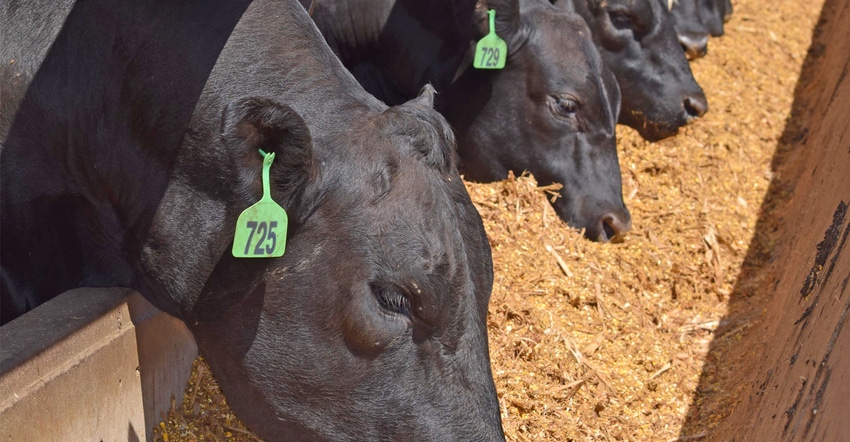August 17, 2020

Almost all July 1 inventory estimates in USDA’s biannual Cattle Report were within 1 percentage point of July 1, 2019 levels. Several factors complicate interpreting the numbers. The list includes large slaughter disruptions in April and May, the prevailing backlog of fed cattle, changes in timing and weight of feedlot placements, drought in some areas, and a less stable economic outlook.
From producer surveys, USDA estimated July 1 U.S. all cattle and calves inventory at 103 million head, up 0.1% or 100,000 head from a year ago, and the largest July 1 herd since 2008. Beef cow numbers shrunk by 0.8%, or 250,000 head from July 1, 2019, to 32.05 million head. USDA projects the 2020 calf crop at 35.8 million head, down 0.7%, or 259,600 head from 2019.
The July 1 beef cow herd is generally larger than the Jan. 1 inventory. Historically, this year’s 2.3% rise would suggest expansion. Beef cow slaughter less so. Through 2020’s first 30 weeks beef cow slaughter averaged 4% ahead of 2019. Before slaughter plant disruptions, weekly harvest was running up 10%, well ahead of 2019. Beef cow slaughter plunged for the seven weeks from April to mid-May.
Year-over-year cuts ran 2% to 20%, averaging down 13%. Since then, through the week ending July 25, beef cow slaughter has been up 6% from 2019. Four of those weeks saw double-digit hikes. June and July figures this much higher are significant, given it took until the end of July for steer and heifer slaughter to get back to 2019 levels.
Potential cattle expansion stalls
Based on the number of beef cows as of July 1, USDA’s Economic Research Service estimates 2.663 million beef replacement heifers entered the herd in January through June. That’s 7.6% more than last year. Beef heifers entering the herd in the first half of 2020 as a percent of the heifers intended for beef replacements on Jan. 1 were 46.1%, the highest level since 2011.
Surveys for the midyear Cattle Report suggest producers intend to keep 4.4 million beef heifers as beef cow replacements, the same as in July 2019. This neutral position would indicate producers are replacing culled cows through normal turnover. Fourth-quarter calf prices will likely be a hinge point and will have a big impact on the Jan. 1, 2021, inventory, but that largely means cow-calf producers will need to “hang on” to see that reality. Abnormally dry and drought conditions persist in some key beef cow regions. The longevity of these weather issues may ultimately dictate carrying capacity of breeding herds.
One inventory estimate that was more than up slightly from 2019 was other heifers, or heifers that will not be bred for beef or dairy replacements. Other heifers, at 8 million head, were 1.3% above a year earlier. USDA’s National Agricultural Statistics Cattle on Feed report estimated 7.033 million steers and 4.405 million heifers were on feed in 1,000-plus-capacity feedlots on July 1. Compared to July 1, 2019, the number of heifers on feed fell 1.5%, while steers rose 0.3%. Heifers represented 38.5% of the number of cattle on feed on July 1, compared to 38.9% last year. These data are a bit misleading though as we would expect heifer feedlot inventories to fall below a year ago after 2019’s large numbers of heifers on feed.
COVID-19 delays feedlot placements
The USDA Economic Research Service web page Livestock & Meat Domestic Data has a table titled “Feeder Cattle Supplies Outside Feedlots.” On April 1, producers had 20.539 million head available to place into feedlots, 3.3% larger than April 1, 2019. This was the highest April number in more than 10 years. Feeder cattle supplies outside feedlots hint at feedlot placements in subsequent months. In this case, it reflects the slowdown in feeder cattle sales.
During March, USDA’s Weekly National Feeder & Stocker Cattle Summary reports, which include auctions, direct and video-internet sales, recorded 590,600 fewer head sold than in March 2019. This April had 448,900 fewer head sold. An obvious outcome of some auction barns being closed and producers trying to ride out the softer market.
Those feeder cattle didn’t disappear, they just stayed on farms longer. June placements were 2.1% higher than a year ago, and were dominated by heavy- and lightweight feeders. Placements of feeder cattle 800 to 1,000 pounds were up 5.7% year over year, with placements 700 to 799 pounds down 7.9%. Meanwhile, placement of feeders under 700 pounds were up 8.8% year over year. Dry conditions, low corn prices and better cattle prices have conspired to move feeders through the system. The 37.4 million head of cattle available to place into feedlots on July 1 were 0.8% larger than last year. This suggests a backlog still exists, but the market is becoming more current.
Cattle and calves on feed in all U.S. feedlots totaled 13.6 million head on July 1, unchanged from 2019. Feedlots with capacity of 1,000 or more had 84.1%, or 11.438 million of the total, down slightly from July 1, 2019. Cattle on feed in U.S. feedlots with less than 1,000-head capacity at 2.162 million head were up 2% compared to a year ago.
Feedlot backup persists
On July 1, feedlots with capacity of 1,000 or more head held 1.299 million cattle that had been on feed for over 180 days. This is up 930,000 head, or 252%, from July 2019. Cattle on feed over 180 days did drop from June 1 to July 1 by 208,000 head, indicating the backlog is shrinking. Still, a lot of cattle remain to be cleaned up to get feedlots current.
After the market works through those burdensome supplies, lower second-quarter placements in response to dismal economic returns should provide relief. Nationally, cattle on feed 150 to 180 days were at par with 2019, while the inventory on feed 120 to 150 days was down 7%. Placing heavier-weight cattle in coming months will add to these pipeline supplies.
On July 1, Iowa feedlots with greater than 1,000-head capacity had 220,000 cattle that had been on feed over 180 days, up 118,000 head, or 116% from a year ago. Iowa feedlots with less than 1,000-head capacity had 9,000 head, or 4% more cattle on feed for more than 180 days.
In Iowa, small Iowa feedlots are the main contributor to larger year-over-year inventories of the next supply of market ready cattle. July 1 inventories on hand for cattle on feed for 120 to 180 days in one- to 999-head-capacity feedlots were up 46,000 head, or 46% from a year ago.
Nationally, USDA estimated July 1 cattle on feed for less than 120 days at 6.58 million head in 1,000-plus-capacity feedlots, down 11% from 2019. Iowa inventories at 196,000 head in large feedlots and 119,000 head in small feedlots were down 37% and 44%, respectively, from a year ago.
In most years, cattle entering feedlots start ramping up in August. Placements typically peak in October. Conditions for feedlots could soon get some relief as breakeven projections are lower than live cattle futures market prices in late 2020 and early 2021. This could help spur feedlot placements.
Schulz is the ISU Extension livestock economist. Email [email protected].
About the Author(s)
You May Also Like


.png?width=300&auto=webp&quality=80&disable=upscale)


